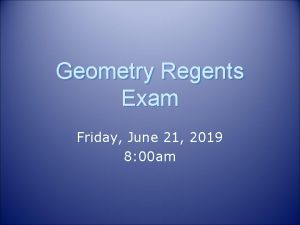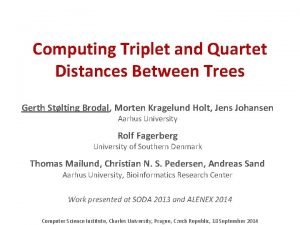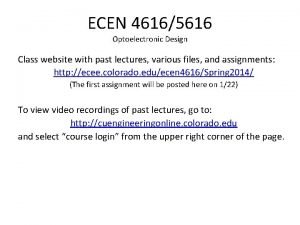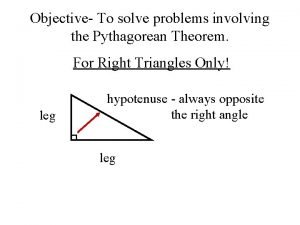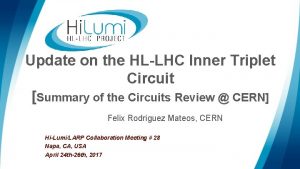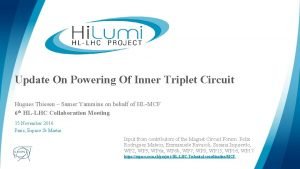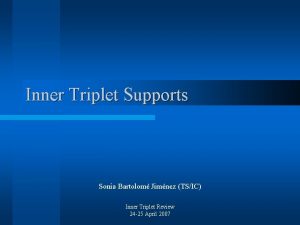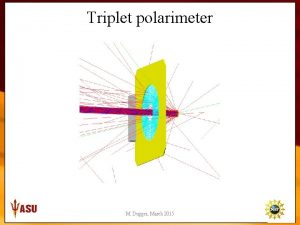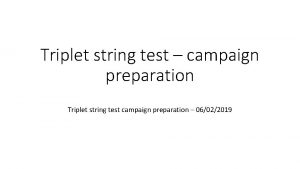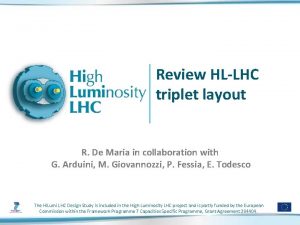HLLHC Inner triplet circuit Update 18 June 2019

![HL-LHC Inner Triplet Circuit – Recent studies § Update of the COSIM [PSPICE+LEDT] reference HL-LHC Inner Triplet Circuit – Recent studies § Update of the COSIM [PSPICE+LEDT] reference](https://slidetodoc.com/presentation_image_h2/81a7ed3ed3bf3ac0605ea22bec97103f/image-2.jpg)









- Slides: 11

HL-LHC Inner triplet circuit Update – 18 June 2019 E. Ravaioli, on behalf of the STEAM team (CERN) Thanks to: B. Lindström, M. Mentink, H. Prin, F. Rodriguez Mateos, A. Verweij, D. Wollman, S. Yammine (CERN) logo area
![HLLHC Inner Triplet Circuit Recent studies Update of the COSIM PSPICELEDT reference HL-LHC Inner Triplet Circuit – Recent studies § Update of the COSIM [PSPICE+LEDT] reference](https://slidetodoc.com/presentation_image_h2/81a7ed3ed3bf3ac0605ea22bec97103f/image-2.jpg)
HL-LHC Inner Triplet Circuit – Recent studies § Update of the COSIM [PSPICE+LEDT] reference model of the HL-LHC Inner Triplet Circuit circuit § Beam failure simulations (LEDET, COMSOL, Mad-X) § Additional coil-to-heater voltage studies § Proposal to modify the warm part of the circuit § Check of ECR’s concerning the circuit (cold Diodes, change of electrical order, etc) § New worst-case simulations for peak temperatures and voltages (conductor parameters, failure cases) § Input to reliability studies § Development of MQXF frequency-domain model (with V. Marinozzi, FNAL) § Development of MQXF app for SM 18 colleagues § Plan to hook STEAM-LEDET to SM 18 data system logo area HL-LHC Inner Triplet Circuit – Update – 18 June 2019 – E. Ravaioli 2

Proposal to modify the warm part of the circuit https: //indico. cern. ch/event/813444/ ECR will be written 1. Connection of Q 1/Q 3 CLIQ units 2. Additional 2 x 10 x back-to-back Diodes across Q 3 b, and ~200 mΩ resistance, using the 35 A leads already in the baseline 2 C 1 C C Note: The present baseline already includes the local 35 A current leads also for the Q 3 cold-mass (due to magnet spare management) logo area 10 x 1 C Courtesy of S. Yammine HL-LHC Inner Triplet Circuit – Recent analysis and optimisation – E. Ravaioli 3

Coil-to-heater voltage studies https: //indico. cern. ch/event/820793/ Example: MQXFB, 7. 15 m long I_ult – No failures – Quench in P 2, outer layer, mid-field turn Summary (semi-quantitative) Input to define new electrical quality assurance tests logo area HL-LHC Inner Triplet Circuit – Recent analysis and optimisation – E. Ravaioli 4

MQXF LEDET app G: ProjectsSTEAMHL-LHCMQXFEl. Ma. Thapp. MQXF_for_testing logo area HL-LHC Inner Triplet Circuit – Recent analysis and optimisation – E. Ravaioli 5

Support slides Main and corrector circuits’ parameters logo area HL-LHC Inner Triplet Circuit – Recent analysis and optimisation – E. Ravaioli 6

Problem with the current baseline Failure case: Spurious triggering of one Q 3 CLIQ unit → Different imposed d. I/dt in the magnet poles → Asymmetric magnetic field in the bore → Fast dipole kick → Possible damage to collimators P 2/P 3/P 4 P 1 t=16 ms here corresponds to t=0 in the next slides logo area Transients simulated with STEAM-COSIM (PSPICE+LEDET) M. Mentink+E. Ravaioli HL-LHC Inner Triplet Circuit – Recent analysis and optimisation – E. Ravaioli 7

Problem with the current baseline Failure case: Spurious triggering of one Q 3 CLIQ unit → Different imposed d. I/dt in the magnet poles → Asymmetric magnetic field in the bore → Fast dipole kick → Possible damage to collimators P 2 P 1 P 3 P 4 Magnetic field change at t=5 ms logo area Magnetic field changes calculated with SIGMA-COMSOL HL-LHC Inner Triplet Circuit – Recent analysis and optimisation – E. Ravaioli 8

Problem with the current baseline Failure case: Spurious triggering of one Q 3 CLIQ unit → Different imposed d. I/dt in the magnet poles → Asymmetric magnetic field in the bore → Fast dipole kick → Possible damage to collimators Damage can be avoided only by detecting the spurious CLIQ unit triggering and reacting extremely quickly (~100 μs). Not impossible, but very challenging! 1. 5 σ in 1 LHC turn Beam simulations by B. Lindström logo area HL-LHC Inner Triplet Circuit – Recent analysis and optimisation – E. Ravaioli 9

Spurious triggering with modified circuit Failure case: Spurious triggering of one Q 3 CLIQ unit → Symmetric imposed d. I/dt in the magnet poles → Almost symmetric magnetic field in the bore → Slower dipole kick → Reduced probability of damage to collimators logo area P 2/P 4 P 1/P 3 Transients simulated with STEAM-COSIM (PSPICE+LEDET) M. Mentink+E. Ravaioli HL-LHC Inner Triplet Circuit – Recent analysis and optimisation – E. Ravaioli 10

Effect on beam of a spurious triggering of a CLIQ unit With present baseline With proposed modification 1. 5σ in >15 LHC turns 1. 5σ in 1 LHC turn logo area Beam simulations by B. Lindström HL-LHC Inner Triplet Circuit – Recent analysis and optimisation – E. Ravaioli 11



